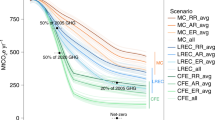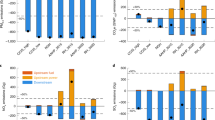Abstract
Electrifying most fossil-fuel-burning applications provides a pathway to achieving cost-effective deep decarbonization of the economy. Heat pumps offer a feasible and energy-efficient way to electrify space heating. Here, we show a positive house price premium associated with air source heat pump installations across 23 states in the United States. Residences with an air source heat pump enjoy a 4.3–7.1% (or US$10,400–17,000) price premium on average. Residents who are environmentally conscious, middle class and live in regions with mild climate are more likely to pay a larger price premium. We find that estimated price premiums are larger than the calculated total social benefits of switching to heat pumps. Policymakers could provide information about the estimated price premium to influence the adoption of heat pumps.
This is a preview of subscription content, access via your institution
Access options
Access Nature and 54 other Nature Portfolio journals
Get Nature+, our best-value online-access subscription
$29.99 / 30 days
cancel any time
Subscribe to this journal
Receive 12 digital issues and online access to articles
$119.00 per year
only $9.92 per issue
Buy this article
- Purchase on Springer Link
- Instant access to full article PDF
Prices may be subject to local taxes which are calculated during checkout




Similar content being viewed by others
Data availability
Individual property data were provided by Zillow through the Zillow Transaction and Assessment Database (ZTRAX). More information on accessing the data can be found at https://www.zillow.com/research/ztrax/. The data are proprietary and are not publicly available under a non-disclosure agreement with Zillow. Interested readers can submit a request to Zillow for approval to obtain the data. Other data used for this analysis are available from the publicly available sources cited or from the authors upon reasonable request. Source data are provided with this paper.
Code availability
The custom code of the data processing and analysis is deposited and managed on GitHub (https://github.com/willshen21/heat-pump-house-price-premium).
References
IPCC Special Report on Global Warming of 1.5 °C (eds Masson-Delmotte, V. et al.) (WMO, 2018).
Denis, A. et al. Pathways to deep decarbonization - 2015 report (Sustainable Development Solutions Network, Institute for Sustainable Development and International Relations, 2015).
Hultman, N. et al. Accelerating America’s Pledge: Going All-in to Build a Prosperous, Low-Carbon Economy for the United States (University of Maryland Center for Global Sustainability, Rocky Mountain Institute, World Resources Institute, Bloomberg Philanthropies, 2019).
Davis, S. et al. Net-zero emissions energy systems. Science 360, eaas9793 (2018).
Lucon, O. et al. in Climate Change 2014: Mitigation of Climate Change (eds Edenhofer, O. et al.) (IPCC, Cambridge Univ. Press, 2014).
MacKay, D. Sustainable Energy - Without The Hot Air (UIT Cambridge: 2008). .
The heat is on. Nature 450, 319–319 (2007).
Biardeau, L., Davis, L., Gertler, P. & Wolfram, C. Heat exposure and global air conditioning. Nat. Sustain. 3, 25–28 (2019).
Aydin, E., Eichholtz, P. & Yönder, E. The economics of residential solar water heaters in emerging economies: the case of Turkey. Energy Econ. 75, 285–299 (2018).
Qiu, Y., Wang, Y. & Wang, J. Soak up the sun: impact of solar energy systems on residential home values in Arizona. Energy Econ. 66, 328–336 (2017).
Hoen, B., Wiser, R., Thayer, M. & Cappers, P. Residential photovoltaic energy systems in California: the effect on home sales prices. Contemp. Econ. Policy 31, 708–718 (2012).
Dastrup, S., Graff Zivin, J., Costa, D. & Kahn, M. Understanding the solar home price premium: electricity generation and “green” social status. Eur. Econ. Rev. 56, 961–973 (2012).
Walls, M., Gerarden, T., Palmer, K. & Bak, X. Is energy efficiency capitalized into home prices? Evidence from three U.S. cities. J. Environ. Econ. Manage. 82, 104–124 (2017).
Kahn, M. & Kok, N. The capitalization of green labels in the California housing market. Reg. Sci. Urban Econ. 47, 25–34 (2014).
Deng, Y., Li, Z. & Quigley, J. Economic returns to energy-efficient investments in the housing market: evidence from Singapore. Reg. Sci. Urban Econ. 42, 506–515 (2012).
Deng, Y. & Wu, J. Economic returns to residential green building investment: the developers’ perspective. Reg. Sci. Urban Econ. 47, 35–44 (2014).
Brounen, D. & Kok, N. On the economics of energy labels in the housing market. J. Environ. Econ. Manage. 62, 166–179 (2011).
Jayantha, W. M. & Man, W. S. Effect of green labelling on residential property price: a case study in Hong Kong. J. Facil. Manage. 11, 31–51 (2013).
Eichholtz, P., Kok, N. & Quigley, J. Doing well by doing good? Green office buildings. Am. Econ. Rev. 100, 2492–2509 (2010).
Eichholtz, P., Kok, N. & Quigley, J. The economics of green building. Rev. Econ. Stat. 95, 50–63 (2013).
Costa, O., Fuerst, F., Robinson, S. & Mendes-Da-Silva, W. Green label signals in an emerging real estate market: a case study of Sao Paulo, Brazil. J. Clean. Prod. 184, 660–670 (2018).
Fowlie, M., Greenstone, M. & Wolfram, C. Do energy efficiency investments deliver? Evidence from the weatherization assistance program. Q. J. Econ. 133, 1597–1644 (2018).
Allcott, H. & Greenstone, M. Is there an energy efficiency gap? J. Econ. Perspect. 26, 3–28 (2012).
Gillingham, K. & Palmer, K. Bridging the energy efficiency gap: policy insights from economic theory and empirical evidence. Rev. Environ. Econ. Policy 8, 18–38 (2014).
Gerarden, T., Newell, R. & Stavins, R. Deconstructing the energy-efficiency gap: conceptual frameworks and evidence. Am. Econ. Rev. 105, 183–186 (2015).
Liang, J. et al. Do energy retrofits work? Evidence from commercial and residential buildings in Phoenix. J. Environ. Econ. Manage. 92, 726–743 (2018).
Zillow’s Assessor and Real Estate Database (Zillow Research, 2020); https://www.zillow.com/research/ztrax/
Kuminoff, N. & Pope, J. Do “capitalization effects” for public goods reveal the public’s willingness to pay? Int. Econ. Rev. 55, 1227–1250 (2014).
Muehlenbachs, L., Spiller, E. & Timmins, C. The housing market impacts of shale gas development. Am. Econ. Rev. 105, 3633–3659 (2015).
US Energy Information Administration. Residential Energy Consumption Survey (RECS) https://www.eia.gov/consumption/residential/data/2015/ (2020).
Mense, A. The value of energy efficiency and the role of expected heating costs. Environ. Resour. Econ. 71, 671–701 (2017).
Howe, P., Mildenberger, M., Marlon, J. & Leiserowitz, A. Geographic variation in opinions on climate change at state and local scales in the USA. Nat. Clim. Change 5, 596–603 (2015).
Cai, Z., Fang, Y., Lin, M. & Su, J. Inferences for a partially varying coefficient model with endogenous regressors. J. Bus. Econ. Stat. 37, 158–170 (2017).
Strong, D. Impacts of diffusion policy: determinants of early smart meter diffusion in the US electric power industry. Ind. Corp. Change 28, 1343–1363 (2019).
Walden, E. & Browne, G. Sequential adoption theory: a theory for understanding herding behavior in early adoption of novel technologies. J. Assoc. Inf. Syst. 10, 31–62 (2009).
Mulder, P., de Groot, H. & Hofkes, M. Explaining slow diffusion of energy-saving technologies: a vintage model with returns to diversity and learning-by-using. Resour. Energy Econ. 25, 105–126 (2003).
Bollinger, B. & Gillingham, K. Learning-by-doing in solar photovoltaic installations. SSRN https://doi.org/10.2139/ssrn.2342406 (2014).
Gillingham, K. et al. Deconstructing solar photovoltaic pricing. Energy J. 37, 231–250 (2016).
Houde, S. How consumers respond to product certification and the value of energy information. Rand J. Econ. 49, 453–477 (2018).
Ito, K. Do consumers respond to marginal or average price? Evidence from nonlinear electricity pricing. Am. Econ. Rev. 104, 537–563 (2014).
Brent, D. & Ward, M. Energy efficiency and financial literacy. J. Environ. Econ. Manage. 90, 181–216 (2018).
Barbose, G., Darghouth, N., LaCommare, K., Millstein, D. & Rand, J. Tracking the Sun: Installed Price Trends for Distributed Photovoltaic Systems in the United States - 2018 Edition (Lawrence Berkeley National Laboratory, 2018).
Qiu, Y., Colson, G. & Grebitus, C. Risk preferences and purchase of energy-efficient technologies in the residential sector. Ecol. Econ. 107, 216–229 (2014).
CNBC. Here’s how much money Americans have in savings at every income level https://www.cnbc.com/2018/09/27/heres-how-much-money-americans-have-in-savings-at-every-income-level.html (2018).
Angrist, J.Harmless Econometrics: An Empiricist’s Companion (Princeton Univ. Press, 2008).
Imbens, G. Nonparametric estimation of average treatment effects under exogeneity: a review. Rev. Econ. Stat. 86, 4–29 (2004).
Lechner, M. The estimation of causal effects by difference-in-difference methods estimation of spatial panels. Found. Trends Econom. 4, 165–224 (2010).
Gallin, J. The long-run relationship between house prices and income: evidence from local housing markets. Real Estate Econ. 34, 417–438 (2006).
Myers, E. Are home buyers inattentive? Evidence from capitalization of energy costs. Am. Econ. J. Econ. Pol. 11, 165–188 (2019).
Lundberg, A., Huynh, K. & Jacho-Chávez, D. Income and democracy: a smooth varying coefficient redux. J. Appl. Econom. 32, 719–724 (2016).
Delgado, M., McCloud, N. & Kumbhakar, S. A generalized empirical model of corruption, foreign direct investment, and growth. J. Macroecon. 42, 298–316 (2014).
Su, L., Murtazashvili, I. & Ullah, A. Local linear GMM estimation of functional coefficient IV models with an application to estimating the rate of return to schooling. J. Bus. Econ. Stat. 31, 184–207 (2013).
Macrotrends. Federal funds rate - 62 year historical chart https://www.macrotrends.net/2015/fed-funds-rate-historical-chart (2020).
Bureau of Economic Analysis, US Department of Commerce. Regional data: GDP and income https://apps.bea.gov/itable/iTable.cfm?ReqID=70&step=1 (2019).
US Energy Information Administration. Natural gas prices https://www.eia.gov/dnav/ng/ng_pri_sum_a_EPG0_PRS_DMcf_m.htm (2019).
US Energy Information Administration. Electricity: detailed state data https://www.eia.gov/electricity/data/state/ (2019).
Climate data online. National Oceanic and Atmospheric Administration ftp://ftp.ncdc.noaa.gov/pub/data/normals/1981-2010/ (2020).
Acknowledgements
The results and opinions are those of the authors and do not reflect the position of Zillow Group. Funding for this research was provided by the Alfred P. Sloan Foundation. We thank A. Albertini, Y. Niu, T. Deetjen, T. Schmidt, E. Wilson and seminar participants at the Center for Global Sustainability for helpful comments during the preparation of this paper.
Author information
Authors and Affiliations
Contributions
X.S., P.L. and Y.Q. designed the study and planned the analysis. X.S. conducted the data analysis and drafted the paper. P.L., Y.Q. and P.V. edited the paper. P.V. provided initial calculations on private and social benefits. All authors offered revision suggestions and contributed to the interpretation of the findings.
Corresponding author
Ethics declarations
Competing interests
The authors declare no competing interests.
Additional information
Publisher’s note Springer Nature remains neutral with regard to jurisdictional claims in published maps and institutional affiliations.
Supplementary information
Supplementary Information
Supplementary Notes 1–9, Figs. 1–8, Tables 1–17 and refs. 1–21.
Source data
Source Data Fig. 1
Data points on Figure 1.
Source Data Fig. 2
Data points on Figure 2.
Source Data Fig. 3
Data points on Figure 3a–f.
Source Data Fig. 4
Data points on Figure 4.
Rights and permissions
About this article
Cite this article
Shen, X., Liu, P., Qiu, Y. et al. Estimation of change in house sales prices in the United States after heat pump adoption. Nat Energy 6, 30–37 (2021). https://doi.org/10.1038/s41560-020-00706-4
Received:
Accepted:
Published:
Issue Date:
DOI: https://doi.org/10.1038/s41560-020-00706-4
This article is cited by
-
Evaluate the Impacts of Wind Farm Facilities on Land Values with Geographically-Linked Microdata in China
Environmental and Resource Economics (2024)
-
Heat pump supply chain environmental impact reduction to improve the UK energy sustainability, resiliency and security
Scientific Reports (2023)
-
Effects of expanding electric vehicle charging stations in California on the housing market
Nature Sustainability (2023)
-
Impact of ground source heat pumps on house sales prices in Finland
Energy Efficiency (2023)
-
Gridded land use data for the conterminous United States 1940–2015
Scientific Data (2022)



